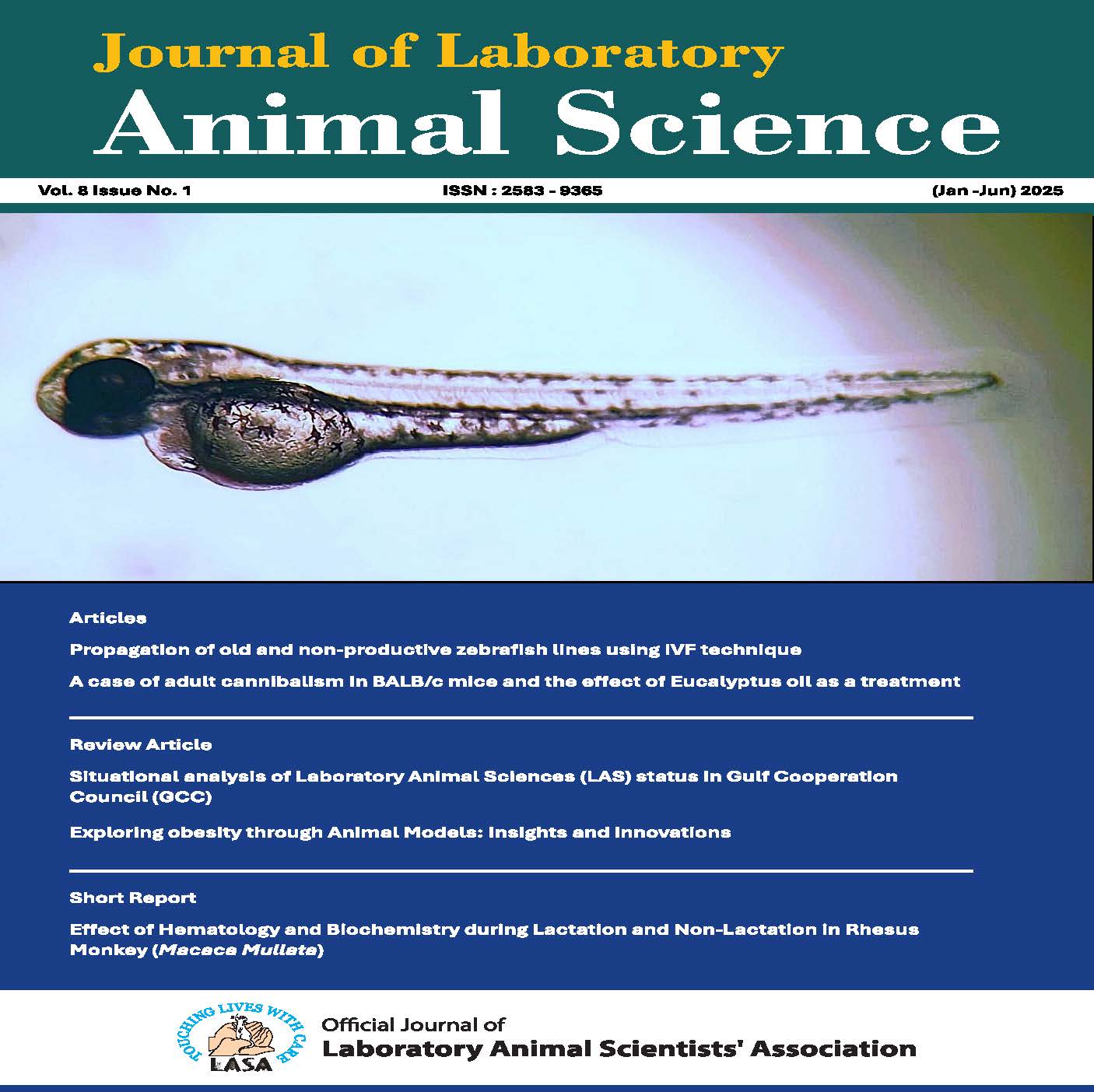Genetic Monitoring of Laboratory Rodents Using Single Nucleotide Polymorphisms
DOI:
https://doi.org/10.48165/jlas.2026.9.1.1Keywords:
Single-nucleotide polymorphism, genetic monitoring, laboratory rodentAbstract
Maintaining the genetic integrity of laboratory rodents is essential for achieving reliable and reproducible results in bio medical experiments. Genetic variations among laboratory animals can lead to flawed results, highlighting the impor tance of rigorous quality control testing. Among various genetic markers, single-nucleotide polymorphisms (SNPs) are the most common and provide a dependable method for genetic monitoring due to their precision and stability. These markers support efficient, cost-effective, and high-throughput genotyping strategies. This study aims to standardize SNP detection as a genetic monitoring tool in laboratory rodents using the Amplification Refractory Mutation System (ARMS) PCR. Genomic DNA was isolated from ten mouse strains: A/J, BALB/c, C3H/J, CD-1, C57BL/6, DBA/2, FVB/ NJ, Swiss Webster, Swiss/Bare, and BDF1. The DNA was obtained from tail tissue samples using the phenol–chloroform extraction technique, followed by quantification with a Nanodrop spectrophotometer. DNA quality was assessed through agarose gel electrophoresis. SNP markers were chosen based on polymorphisms from the Mouse Genome Informatics (MGI) database, and primers were designed using the PRIMER1 tool. We optimized PCR conditions by systematically varying parameters like DNA concentration, PCR cycles, annealing temperature, Taq mix concentration, and reaction volume. We achieved reproducible amplification for selected SNP markers through methodical optimization, with 10 of the 19 tested markers yielding clear allele distinction across strains. The ARMS PCR approach provided straightforward, reliable genotyping without requiring restriction enzyme digestion or complex data interpretation. Our findings demon strate that ARMS PCR can be a cost-effective tool for genetic monitoring in laboratory colonies. Future work will involve sequencing amplified products to confirm allele assignments and validate the method’s accuracy.
Downloads
References
Almeida, J. L., & Korch, C. T. (2004). Authentication of human and mouse cell lines by short tandem repeat (STR) DNA genotype analysis. In: Markossian, S., Grossman, A., Arkin, M., et al. (Eds.), Assay Guidance Manual. Eli Lilly & Company and the National Center for Advancing Translational Sciences. Available from http://www.ncbi.nlm.nih.gov/books/NBK144066/
Andrew, K. R., Hunter, S. S., Torrevilas, B. K., et al. (2021). A new mouse SNP genotyping assay for speed congenics: Combining flexibility, affordability, and power. BMC Genomics, 22, 378. https://doi.org/10.1186/s12864-021-07698-9
Antony, D., Ahire, S., & Ingle, A. (2022). Maximising modern diagnostic approaches to assess genetic contamination in laboratory rodents. Indian Veterinary Journal, 99(7), 24–34. https://ivj.org.in/journal-issue-viewer/15d83a3b-87a4-41a0-b2ec-d7e8b560e67e/
Benavides, F., Rülicke, T., Prins, J. B., et al. (2020). Genetic quality assurance and genetic monitoring of laboratory mice and rats: FELASA Working Group Report. Laboratory Animals, 54(2), 135–148. https://doi.org/10.1177/0023677219867719
Bryda, E. C., & Riley, L. K. (2008). Multiplex microsatellite marker panels for genetic monitoring of common rat strains. Journal of the American Association for Laboratory Animal Science, 47(3), 37–41.
Bryda, E. C. (2013). The mighty mouse: The impact of rodents on advances in biomedical research. Mo Med, 110(3), 207–211. PMID: 23829104
Carbone, L. (2021). Estimating mouse and rat use in American laboratories by extrapolation from Animal Welfare Act regulated species. Scientific Reports, 11, 493. https://doi.org/10.1038/s41598-020-79961-0
Cui, S. F., Zhou, Q., & Qu, X. H. (2012). SNP genotyping for the genetic monitoring of laboratory mice by using a microarray-based method with dual-colour fluorescence hybridisation. Alternatives to Laboratory Animals, 40(3), 155–163. https://doi.org/10.1177/026119291204000308
Harris, S., & Jones, D. B. (1997). Optimisation of the polymerase chain reaction. British Journal of Biomedical Science, 54(3), 166–173.
Hickman, D. L., Johnson, J., Vemulapalli, T. H., et al. (2017). Commonly used animal models. In Principles of Animal Research for Graduate and Undergraduate Students (pp. 117–175). https://doi.org/10.1016/B978-0-12-802151-4.00007-4
Kalendar, R., Shustov, A. V., Akhmetollayev, I., et al. (2022). Designing allele-specific competitive-extension PCR based assays for high-throughput genotyping and gene characterization. Frontiers in Molecular Biosciences, 9, 773956. https://doi.org/10.3389/fmolb.2022.773956
Kalia, R. K., Rai, M. K., Kalia, S., et al. (2011). Microsatellite markers: An overview of the recent progress in plants. Euphytica, 177(3), 309–334. https://doi.org/10.1007/s10681-010-0286-9
Korbie, D. J., & Mattick, J. S. (2008). Touchdown PCR for increased specificity and sensitivity in PCR amplification. Nature Protocols, 3(9), 1452–1456. https://doi.org/10.1038/nprot.2008.133
Lee, S. J., Park, S.-Y., Lee, K.-H., et al. (2023). Development of a simple direct and hot-start PCR using Escherichia coli-expressing Taq DNA polymerase. International Journal of Molecular Sciences, 24, 11405. https://www.mdpi.com/1422-0067/24/14/11405
Liu, N., Chen, L., Wang, S., Oh, C., & Zhao, H. (2005). Comparison of single-nucleotide polymorphisms and microsatellites in inference of population structure. BMC Genetics, 6(Suppl 1), S26. https://doi.org/10.1186/1471-2156-6-S1-S26
Matsuda, K. (2017). PCR-based detection methods for single-nucleotide polymorphism or mutation: Real-time PCR and its substantial contribution toward technological refinement. In G. S. Makowski (Ed.), Advances in Clinical Chemistry, Vol 80 (pp. 45–72). Elsevier. https://doi.org/10.1016/bs.acc.2016.11.002
Naseem, A., Ahire, S., & Ingle, A. (2022). Multiplexing: An efficient way of genetic monitoring of laboratory mice using microsatellite markers. Agricultural Science Digest, 42(3), 358–364. https://arccjournals.com/journal/agricultural-science-digest/D-5470
Newton, C. R., Graham, A., Heptinstall, L., et al. (1989). Analysis of any point mutation in DNA: The amplification refractory mutation system (ARMS). Nucleic Acids Research, 17, 2503. https://doi.org/10.1093/nar/17.7.2503
Nitzki, F., Kruger, A., Reifenberg, K., et al. (2007). Identification of a genetic contamination in a commercial mouse strain using two panels of polymorphic markers. Laboratory Animals, 41(2), 218–228. https://doi.org/10.1258/002367707780378104
Petkov, P. M., Cassell, M. A., Sargent, E. E., et al. (2004). Development of a SNP genotyping panel for genetic monitoring of the laboratory mouse. Genomics, 83(5), 902–911. https://doi.org/10.1016/j.ygeno.2003.11.007
Ruan, F. V. M., & Oliveira, C. A. (2024). Guidelines for the tetra-primer ARMS–PCR technique development. Molecular Biotechnology, 56, 599–608. https://link.springer.com/article/10.1007/s12033-014-9734-4
Thorat, R., & Ingle, A. (2012). An attempt of cryopreservation of mouse embryos at the ACTREC laboratory animal facility in India. Experimental Animals, 61(2), 139–145. https://doi.org/10.1538/expanim.61.139
Thorat, R., Ahire, S., & Ingle, A. (2013). Re-establishment of a breeding colony of immunocompromised mice through revival of cryopreserved embryos. Laboratory Animals (NY), 42(4), 131–134. https://doi.org/10.1038/laban.191

